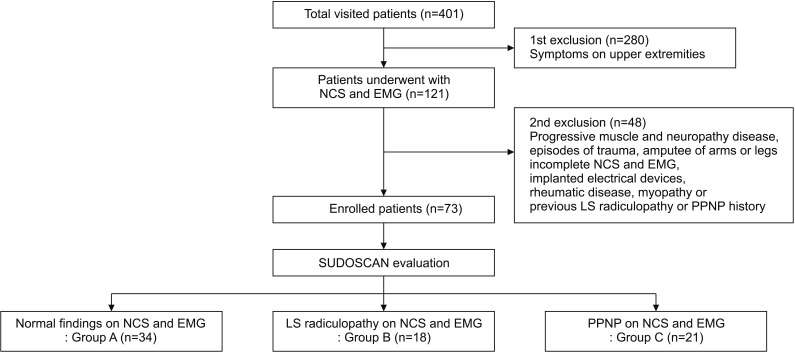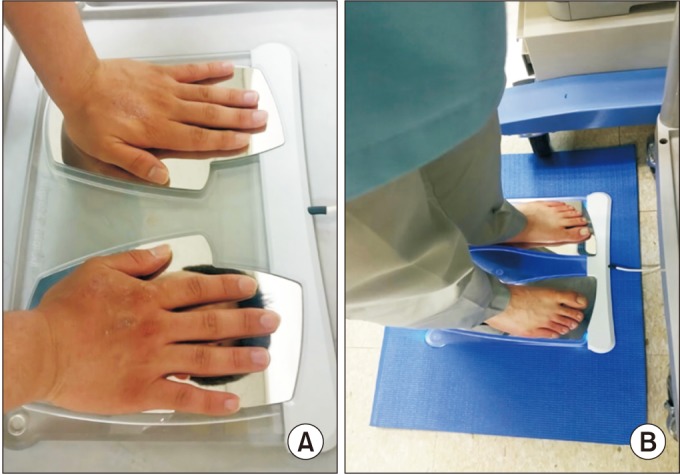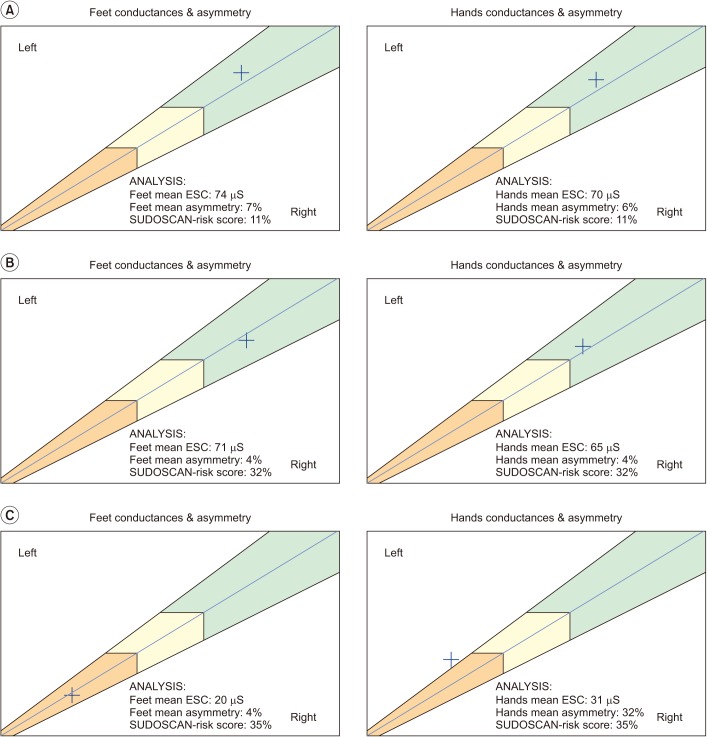Ann Rehabil Med.
2017 Dec;41(6):1028-1038. 10.5535/arm.2017.41.6.1028.
Rapid, Objective and Non-invasive Diagnosis of Sudomotor Dysfunction in Patients With Lower Extremity Dysesthesia: A Cross-Sectional Study
- Affiliations
-
- 1Department of Rehabilitation Medicine, Seoul St. Mary's Hospital, College of Medicine, The Catholic University of Korea, Seoul, Korea.
- 2Department of Rehabilitation Medicine, Bucheon St. Mary's Hospital, College of Medicine, The Catholic University of Korea, Bucheon, Korea. lafolia@catholic.ac.kr
- 3Department of Rehabilitation Medicine, Dongsan Medical Center, School of Medicine, Keimyung University, Daegu, Korea.
- KMID: 2400288
- DOI: http://doi.org/10.5535/arm.2017.41.6.1028
Abstract
OBJECTIVE
To determine whether patients with lumbosacral (LS) radiculopathy and peripheral polyneuropathy (PPNP) exhibit sudomotor abnormalities and whether SUDOSCAN (Impeto Medical, Paris, France) can complement nerve conduction study (NCS) and electromyography (EMG).
METHODS
Outpatients with lower extremity dysesthesia underwent electrophysiologic studies and SUDOSCAN. They were classified as normal (group A), LS radiculopathy (group B), or PPNP (group C). Pain severity was measured by the Michigan Neuropathy Screening Instrument (MNSI) and visual analogue scale (VAS). Demographic features, electrochemical skin conductance (ESC) values on hands and feet, and SUDOSCAN-risk scores were analyzed.
RESULTS
There were no statistical differences in MNSI and VAS among the three groups. Feet-ESC and hands-ESC values in group C were lower than group A and B. SUDOSCAN-risk score in group B and C was higher than group A. With a cut-off at 48 microSiemens of feet-ESC, PPNP was detected with 57.1% sensitivity and 94.2% specificity (area under the curve [AUC]=0.780; 95% confidence interval [CI], 0646-0.915). With a SUDOSCAN-risk score cut-off at 29%, NCS and EMG abnormalities related to LS radiculopathy and PPNP were detected with 64.1% sensitivity and 84.2% specificity (AUC=0.750; 95% CI, 0.674-0.886).
CONCLUSION
SUDOSCAN can discriminate outpatients with abnormal electrophysiological findings and sudomotor dysfunction. This technology may be a complementary tool to NCS and EMG in outpatients with lower extremity dysesthesia.
Keyword
MeSH Terms
-
Complement System Proteins
Cross-Sectional Studies*
Diabetes Mellitus
Diagnosis*
Electromyography
Erythromelalgia
Foot
Galvanic Skin Response
Hand
Humans
Lower Extremity*
Mass Screening
Michigan
Neural Conduction
Outpatients
Paresthesia*
Polyneuropathies
Radiculopathy
Sensitivity and Specificity
Skin
Complement System Proteins
Figure
Reference
-
1. Gunn CC. Radiculopathic pain: diagnosis and treatment of segmental irritation or sensitization. J Musculoskelet Pain. 1997; 5:119–134.
Article2. Spijker-Huiges A, Groenhof F, Winters JC, van Wijhe M, Groenier KH, van der Meer K. Radiating low back pain in general practice: incidence, prevalence, diagnosis, and long-term clinical course of illness. Scand J Prim Health Care. 2015; 33:27–32. PMID: 25693788.
Article3. Beith ID, Kemp A, Kenyon J, Prout M, Chestnut TJ. Identifying neuropathic back and leg pain: a cross-sectional study. Pain. 2011; 152:1511–1516. PMID: 21396774.
Article4. Mete T, Aydin Y, Saka M, Cinar Yavuz H, Bilen S, Yalcin Y, et al. Comparison of efficiencies of michigan neuropathy screening instrument, neurothesiometer, and electromyography for diagnosis of diabetic neuropathy. Int J Endocrinol. 2013; 2013:821745. PMID: 23818897.
Article5. Dyck PJ, O'Brien PC, Litchy WJ, Harper CM, Klein CJ, Dyck PJ. Monotonicity of nerve tests in diabetes: subclinical nerve dysfunction precedes diagnosis of polyneuropathy. Diabetes Care. 2005; 28:2192–2200. PMID: 16123489.6. Weber F, Albert U. Electrodiagnostic examination of lumbosacral radiculopathies. Electromyogr Clin Neurophysiol. 2000; 40:231–236. PMID: 10907601.7. Chouteau WL, Annaswamy TM, Bierner SM, Elliott AC, Figueroa I. Interrater reliability of needle electromyographic findings in lumbar radiculopathy. Am J Phys Med Rehabil. 2010; 89:561–569. PMID: 20567137.
Article8. Cho SC, Ferrante MA, Levin KH, Harmon RL, So YT. Utility of electrodiagnostic testing in evaluating patients with lumbosacral radiculopathy: an evidence-based review. Muscle Nerve. 2010; 42:276–282. PMID: 20658602.
Article9. Vinik AI, Nevoret ML, Casellini C. The new age of sudomotor function testing: a sensitive and specific biomarker for diagnosis, estimation of severity, monitoring progression, and regression in response to intervention. Front Endocrinol (Lausanne). 2015; 6:94. PMID: 26124748.
Article10. Chan AC, Wilder-Smith EP. Small fiber neuropathy: getting bigger! Muscle Nerve. 2016; 53:671–682. PMID: 26872938.
Article11. Yajnik CS, Kantikar VV, Pande AJ, Deslypere JP. Quick and simple evaluation of sudomotor function for screening of diabetic neuropathy. ISRN Endocrinol. 2012; 2012:103714. PMID: 22830040.
Article12. Casellini CM, Parson HK, Richardson MS, Nevoret ML, Vinik AI. Sudoscan, a noninvasive tool for detecting diabetic small fiber neuropathy and autonomic dysfunction. Diabetes Technol Ther. 2013; 15:948–953. PMID: 23889506.
Article13. Calvet JH, Dupin J, Winiecki H, Schwarz PE. Assessment of small fiber neuropathy through a quick, simple and non invasive method in a German diabetes outpatient clinic. Exp Clin Endocrinol Diabetes. 2013; 121:80–83. PMID: 23073917.
Article14. Selvarajah D, Cash T, Davies J, Sankar A, Rao G, Grieg M, et al. Sudoscan: a simple, rapid, and objective method with potential for screening for diabetic peripheral neuropathy. PLoS One. 2015; 10:e0138224. PMID: 26457582.
Article15. Smith AG, Lessard M, Reyna S, Doudova M, Singleton JR. The diagnostic utility of Sudoscan for distal symmetric peripheral neuropathy. J Diabetes Complications. 2014; 28:511–516. PMID: 24661818.16. El-Badawy MA, El Mikkawy DM. Sympathetic dysfunction in patients with chronic low back pain and failed back surgery syndrome. Clin J Pain. 2016; 32:226–231. PMID: 25968450.
Article17. Erdem Tilki H, Coskun M, Unal Akdemir N, Incesu L. Axon count and sympathetic skin responses in lumbosacral radiculopathy. J Clin Neurol. 2014; 10:10–16. PMID: 24465257.
Article18. Andary MT, Stolov WC, Nutter PB. Sympathetic skin response in fifth lumbar and first sacral radiculopathies. Electromyogr Clin Neurophysiol. 1993; 33:91–99. PMID: 8383595.19. Coster S, de Bruijn SF, Tavy DL. Diagnostic value of history, physical examination and needle electromyography in diagnosing lumbosacral radiculopathy. J Neurol. 2010; 257:332–337. PMID: 19763381.
Article20. Dumitru D, Amato A, Zwarts M. Electrodiagnostic medicine. 2nd ed. Philadelphia: Hanley & Belfus;2002.21. England JD, Gronseth GS, Franklin G, Miller RG, Asbury AK, Carter GT, et al. Distal symmetric polyneuropathy: a definition for clinical research: report of the American Academy of Neurology, the American Association of Electrodiagnostic Medicine, and the American Academy of Physical Medicine and Rehabilitation. Neurology. 2005; 64:199–207. PMID: 15668414.
Article22. Kong X, Lesser EA, Potts FA, Gozani SN. Utilization of nerve conduction studies for the diagnosis of polyneuropathy in patients with diabetes: a retrospective analysis of a large patient series. J Diabetes Sci Technol. 2008; 2:268–274. PMID: 19885354.
Article23. Norman GR, Streiner DL. Biostatistics: the bare essentials. 3rd ed. Hamilton: BC Decker Inc;2008. p. 80.24. Saad M, Psimaras D, Tafani C, Sallansonnet-Froment M, Calvet JH, Vilier A, et al. Quick, non-invasive and quantitative assessment of small fiber neuropathy in patients receiving chemotherapy. J Neurooncol. 2016; 127:373–380. PMID: 26749101.
Article25. Yajnik CS, Kantikar V, Pande A, Deslypere JP, Dupin J, Calvet JH, et al. Screening of cardiovascular autonomic neuropathy in patients with diabetes using non-invasive quick and simple assessment of sudomotor function. Diabetes Metab. 2013; 39:126–131. PMID: 23159130.
Article26. Chung K, Kim HJ, Na HS, Park MJ, Chung JM. Abnormalities of sympathetic innervation in the area of an injured peripheral nerve in a rat model of neuropathic pain. Neurosci Lett. 1993; 162:85–88. PMID: 7907173.
Article27. Bernini PM, Simeone FA. Reflex sympathetic dystrophy associated with low lumbar disc herniation. Spine (Phila Pa 1976). 1981; 6:180–184. PMID: 7280819.
Article28. Jinkins JR, Whittemore AR, Bradley WG. The anatomic basis of vertebrogenic pain and the autonomic syndrome associated with lumbar disk extrusion. AJR Am J Roentgenol. 1989; 152:1277–1289. PMID: 2718865.
Article29. de Andrade DC, Bendib B, Hattou M, Keravel Y, Nguyen JP, Lefaucheur JP. Neurophysiological assessment of spinal cord stimulation in failed back surgery syndrome. Pain. 2010; 150:485–491. PMID: 20591571.
Article30. North RB, Kidd DH, Farrokhi F, Piantadosi SA. Spinal cord stimulation versus repeated lumbosacral spine surgery for chronic pain: a randomized, controlled trial. Neurosurgery. 2005; 56:98–106.
Article31. Kimura J. Electrodiagnosis in disease of nerve and muscle: principles and practice. 3rd ed. New York: Oxford University Press;2001. p. 130.32. Low PA. Evaluation of sudomotor function. Clin Neurophysiol. 2004; 115:1506–1513. PMID: 15203051.
Article33. Akobeng AK. Understanding diagnostic tests 1: sensitivity, specificity and predictive values. Acta Paediatr. 2007; 96:338–341. PMID: 17407452.
Article34. Bhandari M, Guyatt GH. How to appraise a diagnostic test. World J Surg. 2005; 29:561–566. PMID: 15827842.
Article35. Kanchanaraksa S. Evaluation of diagnostic and screening tests: validity and reliability. Baltimore: John Hopkins University;2008.
- Full Text Links
- Actions
-
Cited
- CITED
-
- Close
- Share
- Similar articles
-
- Characteristics of Coping Strategies for Dysesthesia in Preoperative Patients with Compressive Cervical Myelopathy
- Quantitative sudomotor axon reflex test (QSART) as a diagnostic tool of small fiber neuropathy
- Sonographic Measurement of the Tibialis Posterior Tendon Diameters and Cross Sectional Area in Normal Korean Adults
- Postoperative Dysesthesia Secondary to Thermal Injury Following Biportal Endoscopy for Lumbar Canal Stenosis: A Report of 3 Cases and Technical Details of Radiofrequency
- Measurements of Lower Extremity Blood Flow in Hemiplegic Patients by Doppler Ultrasound




